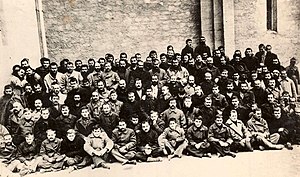| Tatarbunary Uprising | |||||||
|---|---|---|---|---|---|---|---|
 A group of rebels participating in the uprising (FOCR) | |||||||
| |||||||
| Belligerents | |||||||
|
Supported by: |
| ||||||
| Commanders and leaders | |||||||
|
Andrei Klyushnikov Iustin Batișcev | King Ferdinand I | ||||||
| Strength | |||||||
| 4,000-6,000 rebels | Unknown | ||||||
| Casualties and losses | |||||||
|
3,000 deaths overall 1,600 rebels arrested | |||||||
| Part of a series on the |
| Communist movement in the Kingdom of Romania |
|---|
 |
The Tatarbunary Uprising (Romanian: Răscoala de la Tatarbunar) was a Bolshevik-inspired and Soviet-backed peasant revolt that took place on 15–18 September 1924, in and around the town of Tatarbunary (Tatar-Bunar or Tatarbunar) in Budjak (Bessarabia), then part of Romania, now part of Odesa Oblast, Ukraine. It was led by a pro-Soviet revolutionary committee which called for the creation of a "Moldavian Soviet Republic" and an end to "Romanian occupation".[1]
The uprising was instigated and led by communists from across the Dniester region[2][3][4][5] who were opposed to the establishment of Greater Romania and regarded the Moldovans as a distinct people[6] (later that year, a Moldavian Autonomous Soviet Socialist Republic, roughly corresponding to Transnistria, was established inside the Ukrainian SSR). The Tatarbunary Uprising, as well as the uprisings of Khotyn and Bender, occurred in those regions in which there were very important demographic changes resulting from Tsarist Russia's policy of colonizing Bessarabia with large numbers of Ukrainians, Russians and other nationalities.[7] American professor and expert in Moldovan issues Charles King however considers the revolt, along with other similar rebellions in Romanian-administered Bessarabia, as modern jacqueries.[8]
- ^ Frunză, p. 70; Otu, p. 39
- ^ Clark
- ^ Michael Bruchis, Nations – nationalities - people: a study of the nationalities policy of the Communist Party in Soviet Moldavia, East European Monographs, 1984, p .147
- ^ Meurs, p. 77
- ^ Giuseppe Motta, Un rapporto difficile: Romania e Stati Uniti nel periodo interbellico, FrancoAngeli, Milano, 2006, pg. 55
- ^ Frunză, p.71; Ripa; Troncotă, p.19
- ^ Michael Bruchis, The Republic of Moldavia: from the collapse of the Soviet empire to the restoration of the Russian empire, East European Monographs, 1996, p. 21
- ^ Charles King, The Moldovans. Hoover Press, 2000. p. 52